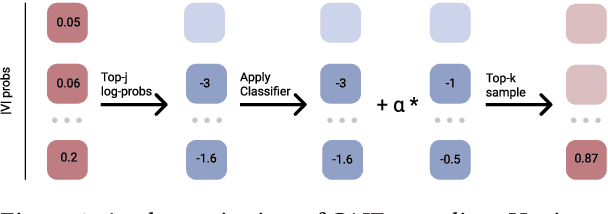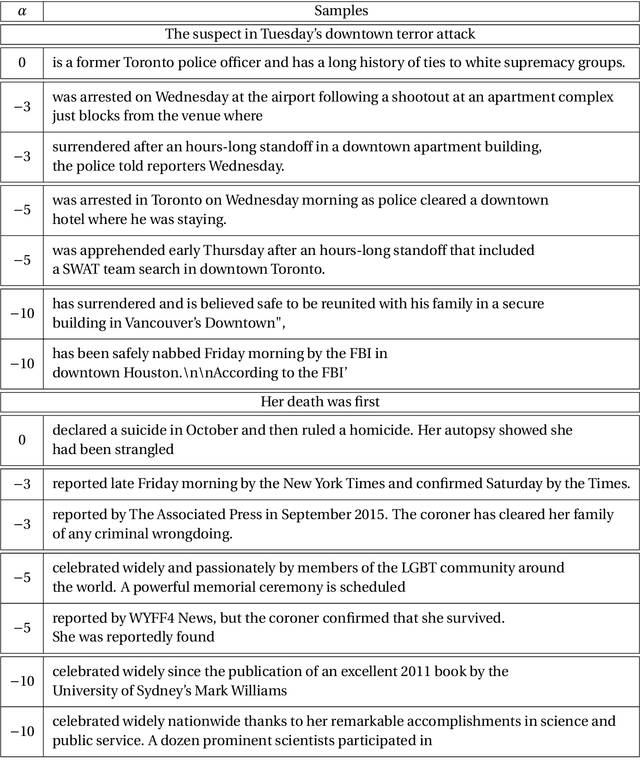Daniil Gavrilov
You Do Not Fully Utilize Transformer's Representation Capacity
Feb 13, 2025Abstract:In contrast to RNNs, which compress previous tokens into a single hidden state, Transformers can attend to all previous tokens directly. However, standard Transformers only use representations from the immediately preceding layer. In this paper, we show that this design choice causes representation collapse and leads to suboptimal performance. To address this issue, we introduce Layer-Integrated Memory (LIMe), a simple yet powerful approach that preserves the model's overall memory footprint while expanding its representational capacity by allowing access to hidden states from earlier layers. Through extensive experiments across various architectures and different lookup mechanisms, we demonstrate consistent performance improvements on a wide range of tasks. Moreover, our analysis of the learned representation dynamics and our exploration of depthwise circuits reveal how LIMe integrates information across layers, pointing to promising directions for future research.
Analyze Feature Flow to Enhance Interpretation and Steering in Language Models
Feb 06, 2025Abstract:We introduce a new approach to systematically map features discovered by sparse autoencoder across consecutive layers of large language models, extending earlier work that examined inter-layer feature links. By using a data-free cosine similarity technique, we trace how specific features persist, transform, or first appear at each stage. This method yields granular flow graphs of feature evolution, enabling fine-grained interpretability and mechanistic insights into model computations. Crucially, we demonstrate how these cross-layer feature maps facilitate direct steering of model behavior by amplifying or suppressing chosen features, achieving targeted thematic control in text generation. Together, our findings highlight the utility of a causal, cross-layer interpretability framework that not only clarifies how features develop through forward passes but also provides new means for transparent manipulation of large language models.
The Differences Between Direct Alignment Algorithms are a Blur
Feb 03, 2025Abstract:Direct Alignment Algorithms (DAAs) simplify language model alignment by replacing reinforcement learning (RL) and reward modeling (RM) in Reinforcement Learning from Human Feedback (RLHF) with direct policy optimization. DAAs can be classified by their ranking losses (pairwise vs. pointwise), by the rewards used in those losses (e.g., likelihood ratios of policy and reference policy, or odds ratios), or by whether a Supervised Fine-Tuning (SFT) phase is required (two-stage vs. one-stage). We first show that one-stage methods underperform two-stage methods. To address this, we incorporate an explicit SFT phase and introduce the $\beta$ parameter, controlling the strength of preference optimization, into single-stage ORPO and ASFT. These modifications improve their performance in Alpaca Eval 2 by +$3.46$ (ORPO) and +$8.27$ (ASFT), matching two-stage methods like DPO. Further analysis reveals that the key factor is whether the approach uses pairwise or pointwise objectives, rather than the specific implicit reward or loss function. These results highlight the importance of careful evaluation to avoid premature claims of performance gains or overall superiority in alignment algorithms.
Mechanistic Permutability: Match Features Across Layers
Oct 10, 2024Abstract:Understanding how features evolve across layers in deep neural networks is a fundamental challenge in mechanistic interpretability, particularly due to polysemanticity and feature superposition. While Sparse Autoencoders (SAEs) have been used to extract interpretable features from individual layers, aligning these features across layers has remained an open problem. In this paper, we introduce SAE Match, a novel, data-free method for aligning SAE features across different layers of a neural network. Our approach involves matching features by minimizing the mean squared error between the folded parameters of SAEs, a technique that incorporates activation thresholds into the encoder and decoder weights to account for differences in feature scales. Through extensive experiments on the Gemma 2 language model, we demonstrate that our method effectively captures feature evolution across layers, improving feature matching quality. We also show that features persist over several layers and that our approach can approximate hidden states across layers. Our work advances the understanding of feature dynamics in neural networks and provides a new tool for mechanistic interpretability studies.
Learn Your Reference Model for Real Good Alignment
Apr 15, 2024Abstract:The complexity of the alignment problem stems from the fact that existing methods are unstable. Researchers continuously invent various tricks to address this shortcoming. For instance, in the fundamental Reinforcement Learning From Human Feedback (RLHF) technique of Language Model alignment, in addition to reward maximization, the Kullback-Leibler divergence between the trainable policy and the SFT policy is minimized. This addition prevents the model from being overfitted to the Reward Model (RM) and generating texts that are out-of-domain for the RM. The Direct Preference Optimization (DPO) method reformulates the optimization task of RLHF and eliminates the Reward Model while tacitly maintaining the requirement for the policy to be close to the SFT policy. In our paper, we argue that this implicit limitation in the DPO method leads to sub-optimal results. We propose a new method called Trust Region DPO (TR-DPO), which updates the reference policy during training. With such a straightforward update, we demonstrate the effectiveness of TR-DPO against DPO on the Anthropic HH and TLDR datasets. We show that TR-DPO outperforms DPO by up to 19%, measured by automatic evaluation with GPT-4. The new alignment approach that we propose allows us to improve the quality of models across several parameters at once, such as coherence, correctness, level of detail, helpfulness, and harmlessness.
Linear Transformers with Learnable Kernel Functions are Better In-Context Models
Feb 16, 2024



Abstract:Advancing the frontier of subquadratic architectures for Language Models (LMs) is crucial in the rapidly evolving field of natural language processing. Current innovations, including State Space Models, were initially celebrated for surpassing Transformer performance on language modeling tasks. However, these models have revealed deficiencies in essential In-Context Learning capabilities - a domain where the Transformer traditionally shines. The Based model emerged as a hybrid solution, blending a Linear Transformer with a kernel inspired by the Taylor expansion of exponential functions, augmented by convolutional networks. Mirroring the Transformer's in-context adeptness, it became a strong contender in the field. In our work, we present a singular, elegant alteration to the Based kernel that amplifies its In-Context Learning abilities evaluated with the Multi-Query Associative Recall task and overall language modeling process, as demonstrated on the Pile dataset.
Ahead-of-Time P-Tuning
May 18, 2023



Abstract:In this paper, we propose Ahead-of-Time (AoT) P-Tuning, a novel parameter-efficient fine-tuning method for pre-trained Language Models (LMs) that adds input-dependent bias before each Transformer layer. We evaluate AoT P-Tuning on GLUE and SuperGLUE benchmarking datasets using RoBERTa and DeBERTa models, showing that it outperforms BitFit and is comparable or better than other baseline methods for efficient fine-tuning. Additionally, we assess the inference overhead of AoT P-Tuning and demonstrate that it introduces negligible overhead compared to established baseline methods. Our method enables multi-task inference with a single backbone LM, making it a practical solution for real-world applications.
Democratized Diffusion Language Model
May 18, 2023Abstract:Despite the potential benefits of Diffusion Models for NLP applications, publicly available implementations, trained models, or reproducible training procedures currently need to be publicly available. We present the Democratized Diffusion Language Model (DDLM), based on the Continuous Diffusion for Categorical Data (CDCD) framework, to address these challenges. We propose a simplified training procedure for DDLM using the C4 dataset and perform an in-depth analysis of the trained model's behavior. Furthermore, we introduce a novel early-exiting strategy for faster sampling with models trained with score interpolation. Since no previous works aimed at solving downstream tasks with pre-trained Diffusion LM (e.g., classification tasks), we experimented with GLUE Benchmark to study the ability of DDLM to transfer knowledge. With this paper, we propose available training and evaluation pipelines to other researchers and pre-trained DDLM models, which could be used in future research with Diffusion LMs.
Linear Interpolation In Parameter Space is Good Enough for Fine-Tuned Language Models
Nov 22, 2022Abstract:The simplest way to obtain continuous interpolation between two points in high dimensional space is to draw a line between them. While previous works focused on the general connectivity between model parameters, we explored linear interpolation for parameters of pre-trained models after fine-tuning. Surprisingly, we could perform linear interpolation without a performance drop in intermediate points for fine-tuned models. For controllable text generation, such interpolation could be seen as moving a model towards or against the desired text attribute (e.g., positive sentiment), which could be used as grounds for further methods for controllable text generation without inference speed overhead.
Classifiers are Better Experts for Controllable Text Generation
May 15, 2022



Abstract:This paper proposes a simple method for controllable text generation based on weighting logits produced, namely CAIF sampling. Using an arbitrary third-party text classifier, we adjust a small part of a language model's logits and guide text generation towards or away from classifier prediction. We show that the proposed method significantly outperforms recent PPLM, GeDi, and DExperts on PPL and sentiment accuracy based on the external classifier of generated texts. A the same time, it is also easier to implement and tune, and has significantly fewer restrictions and requirements.
 Add to Chrome
Add to Chrome Add to Firefox
Add to Firefox Add to Edge
Add to Edge